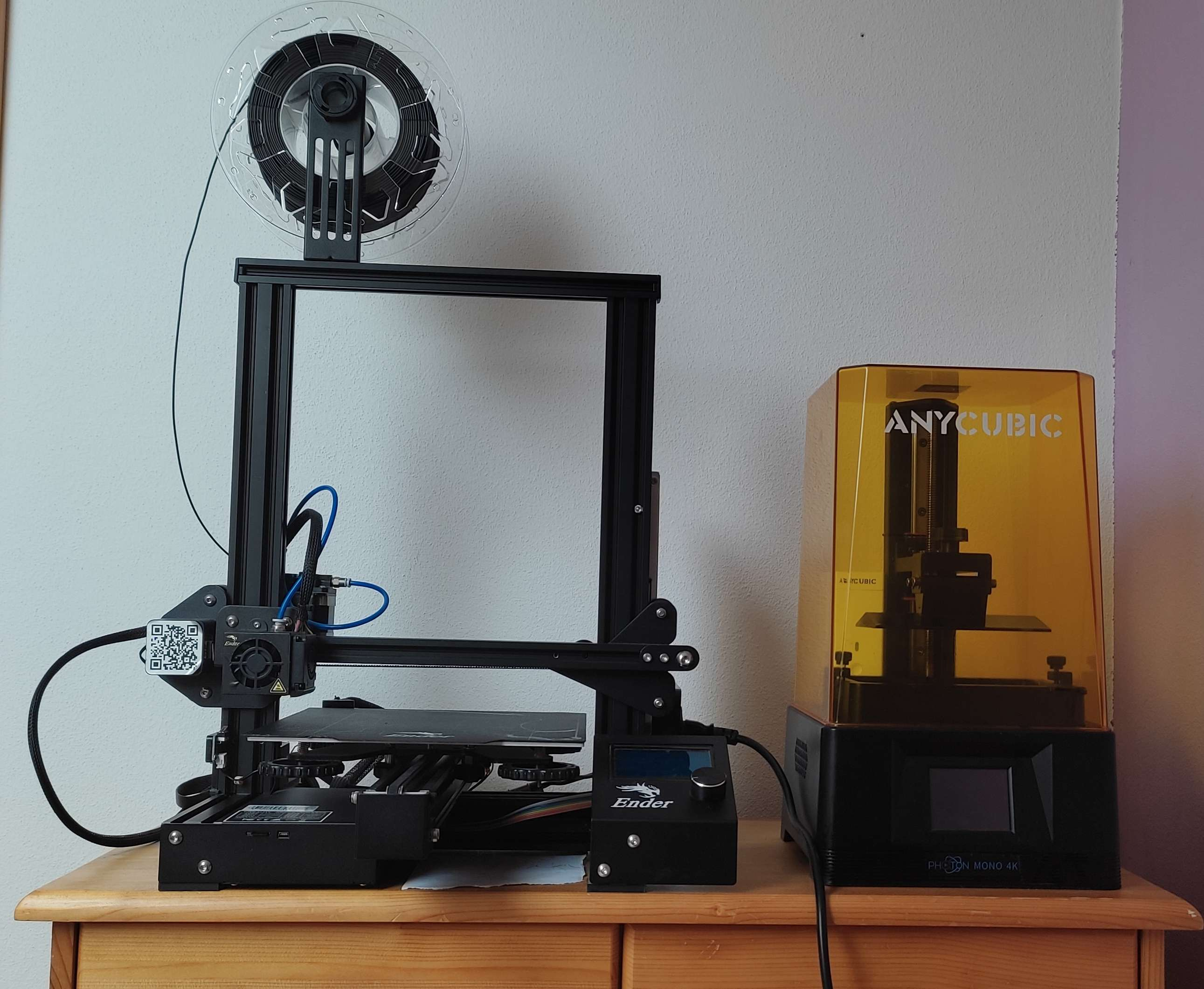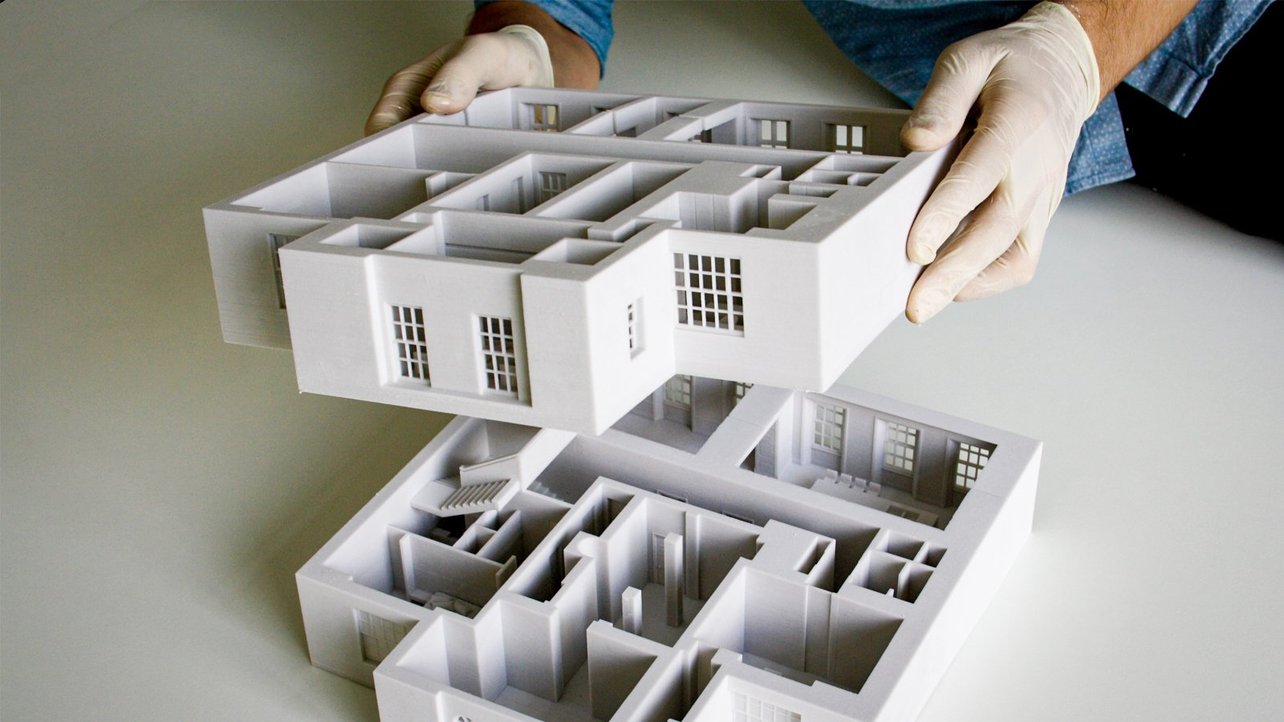About 3D printing
| Portál: | Virtuálna Univerzita Mateja Bela |
| Kurz: | 3D tlač a 3D modelovanie |
| Kniha: | About 3D printing |
| Vytlačil(a): | Hosťovský používateľ |
| Dátum: | streda, 3 júla 2024, 15:32 |
3D priting
3D printing is an additive technology for creating objects. It involves the gradual addition of melted material in horizontal layers onto a substrate. This is the opposite process to the one, where material is gradually removed using tools. Although the specific printing methods can differ from each other, the deposition of material remains a common aspect. Therefore, a 3D model needs to be sliced into thin layers in software before the actual printing process.
As a general rule, the thinner deposited layers the more precise and higher-quality model. However, the hardware itself has its limits in terms of how thin a layer it can create. Even if it could produce very thin layers, we would spend a lot of time in the software that slices the model into those designated layers. This would also extend the printing time, as it would take longer to apply each layer and a larger number of layers would need to be created.

Source: Úvod do 3D tlače - Alena Furdová, Denisa Fialová, Michal Marko, Peter Leško
History of 3D printing
Although it might seem that 3D technology is a novelty of the last decade, it actually originated in the 1980s. However, it only gained attention later due to the availability of 3D printers in regular households.
The foundation for 3D printing was laid by Dr. Kodama in 1980. He was the first to describe the process of adding one layer of material onto another, laying the groundwork for stereolithography (SLA).
Back then, 3D printing was referred to as Rapid Prototyping, primarily serving the purpose of creating prototypes. An illustrative example could be the production of remote controls for TVs. Before a company proceeded with mass production, the remote controls had to be tested – for comfortable grip and whether users could reach all the buttons. To reduce costs, a prototype was 3D printed and then tested. The term "Rapid Prototyping" is still used today.
Charles W. Hull is considered the founder of 3D printing technology. He worked on creating more durable materials using liquid substances that would solidify when exposed to UV light. This gave rise to the idea of inventing a device capable of using this liquid material in layers, then exposing it to UV light to solidify, and repeating the process. In 1983, he successfully produced the first 3D model using this method.

Charles W. Hull - founder of 3D printing (ChuckCharles-Hull-009.jpg (460×276) (guim.co.uk))
In 1984, the first patent was granted for a stereolithographic apparatus that uses UV radiation to solidify prototypes made from photopolymers. The principle involves slicing a 3D model into thin layers using software, which the printer can then stack on top of each other to form a 3D object.
The only challenge was how to convert the file into a format that a 3D printer could interpret and print. The answer was found by the Albert Group Consulting company, with whom Charles W. Hull collaborated, led to the creation of the STL format, usable by any 3D printer. Unlike the SLA process, the STL format was never patented, making it a standard up to the present day.
In 1989, Scott Crump invented a new printing method known as fused deposition modeling (FDM), which uses continuous thermoplastic filament to create individual layers. To enhance this technology, he founded Stratasys, a company that continues to operate successfully. After the FDM patent expired, the market opened up for the development of this currently most widely used form of 3D printing. Additionally, Crump also developed a material for printing known as acrylonitrile butadiene styrene, or ABS, which remains one of the most commonly used materials.
In 1988, Dr. Carl Deckard and Dr. Joe Beaman from the University of Texas at Austin introduced a new concept of 3D printing called selected laser sintering (SLS). Unlike the previous methods, this technique produces prototypes from metal rather than plastic or nylon materials. However, it requires the use of high-power lasers, which can make these printers expensive and unsuitable for home use.
In the 1990s, the Massachusetts Institute of Technology (MIT) developed inkjet 3D printing, which involves depositing droplets of material onto substrates like paper, plastic, and others. This technology's principles have evolved into bioprinting, which involves printing living cells capable of creating tissues, for example.
For many years, 3D printing remained complex and the devices were expensive. However, in 2005, Dr. Bowyer from a United Kingdom university initiated the RepRap project, aiming to create an affordable and open 3D printer platform capable of self-replication. This means having a printer that can create a copy of itself. Data access is open, and based on these data, anyone can print individual components integrated into RepRap. In 2007, the first device named the Darwin 3D printer was created through the project. It operates on the fused filament fabrication (FFF) principle, similar to FDM, which was patented by Stratasys at that time. Despite its limited print quality and accuracy, Darwin demonstrated that 3D printers don't need to be expensive and can be owned by anyone. RepRap continues to evolve, and although not all printer parts can be printed, this project significantly increased the number of 3D printers worldwide.
Source: Úvod do 3D tlače - Alena Furdová, Denisa Fialová, Michal Marko, Peter Leško
Usage of 3D printing
Originally, 3D printing was used for rapid and cost-effective prototyping, but with the advent of cheaper technologies and reduced costs, additional applications emerged. A prime example is small-batch production, which allows companies to manufacture products that are too small to justify the high costs associated with traditional manufacturing setup. Another benefit is the ability to modify a 3D model based on feedback without incurring additional costs.

Jozef Průša at the "printer farm" (6163486_1200x.jpeg (1200×898) (smedata.sk)
Another example is the production of unavailable parts. When repairing antiques or vintage vehicles, replacement parts may not have been available for decades, and often only one piece is needed. The same applies to household appliances, various packaging materials, boxes, or holders.
3D printing has also entered the fields of architecture and construction, providing 3D visualization. Previously, these visualizations were presented in 2D on screens, which wasn't ideal for perceiving space. Architects have transitioned into the 3D space, allowing customers to "walk through" and see their future homes. If we step out of the virtual world, the opportunity for creating physical 3D models arises. Printing offers rapid and cost-effective model production, bridging the communication gap between customers and architects.

3D house model Hobs-3D-modular-model-4-hero.jpg (1284×722) (illustrarch.com)
Personalized manufacturing is another application, where users can print anything they desire. This could involve items like keychains, toys, figurines for tabletop games, replicas, decorations, promotional materials, or various masks and accessories for cosplay[1].

Iron Man mask printed on a 3D printer (eab7232c5d97f77788ce37e4a12d9201.jpg (3264×2448) (pinimg.com))
Application in Medicine
Throughout its history, 3D printing has proven its worth in various industrial fields, and new trends have also influenced the medical sector. In the year 2000, dental implants were 3D printed, and since then, the possibilities for its use have rapidly expanded. Currently, 3D printing is being employed in areas of:
- Cardiology
- Dentistry
- Orthopedics, traumatology
- Ophthalmology
- Rehabilitation
- Neurosurgery
- and others.
In addition to 3D printing, bioprinting is also developing, involving the use of living cells. This technology allows for the printing of vessels, ears, and even organ components. These printed tissues are now being used for testing new drugs. It is anticipated that printing will enable the creation of new organs for transplantation. As the process involves using a patient's own cells to print new tissues, the risk of transplant rejection is minimized, enhancing the success of the operation.
Other medical fields utilize 3D printing for education, real visualization, and procedure planning, as well as the creation of implants and other patient aids.

Source: Úvod do 3D tlače - Alena Furdová, Denisa Fialová, Michal Marko, Peter Leško
Use in Gastronomy
3D printers in the food industry use frozen and dehydrated powdered ingredients contained in capsules that contain micro-nutrients. These ingredients are combined with oils and water to create ready-to-eat foods. The food is created layer by layer, making it possible to prepare dishes with fillings. The printer, resembling a microwave oven, is controlled by consumers through a remote device or sensor controls directly on the printer.
The first 3D food printer emerged as part of a project by a group of scientists and students at Cornell University. The initial inspiration for this project came from the university initiative Far@Home, and its development began in 2005. The first printed food was created at the university in 2011, in the form of cake decorations. In 2013, NASA started funding the development of 3D food printers for producing food for astronauts on long space missions. Micro-nutrients with a shelf life of up to 15 years were developed as a result.
Later, in 2014, the first 3D food printer was introduced to the market by 3D Systems in collaboration with Hershey. The printer was named ChefJet and it could produce confectionery and candy made of milk chocolate or sugar with flavours like mint, cherry, or apple. The printer could create 100 pieces of candy per hour.

Currently, chocolate 3D printers are commonplace. The Choc Edge printer, for instance, can use high-quality Belgian chocolate for printing. Chocolate is applied in layers onto a substrate. Another example is pizza, the preparation of which is similar in principle to regular 3D printing. However, after printing, it must be baked on a special platform. In 2014, the company Natural Machines introduced the prototype of the Foodini printer, which can print not only chocolate but also pasta like ravioli.
A true challenge is printing foods like meat, fruits, and vegetables. Attempts to print bananas, apples, or meat required ingredients to be thoroughly ground, and the resulting food usually didn't resemble its real shape. However, the company Modern Meadow is working on creating lab-grown meat and refining it into its real form using 3D printing. The principle involves cloning stem cells, which can be replicated in a laboratory. After multiplication, the cells are placed in a bio-cartridge. In the printer, this substance is ground, and then a piece of synthetic meat is printed. This printing method can also be used in producing leather or cultivating living human organs.